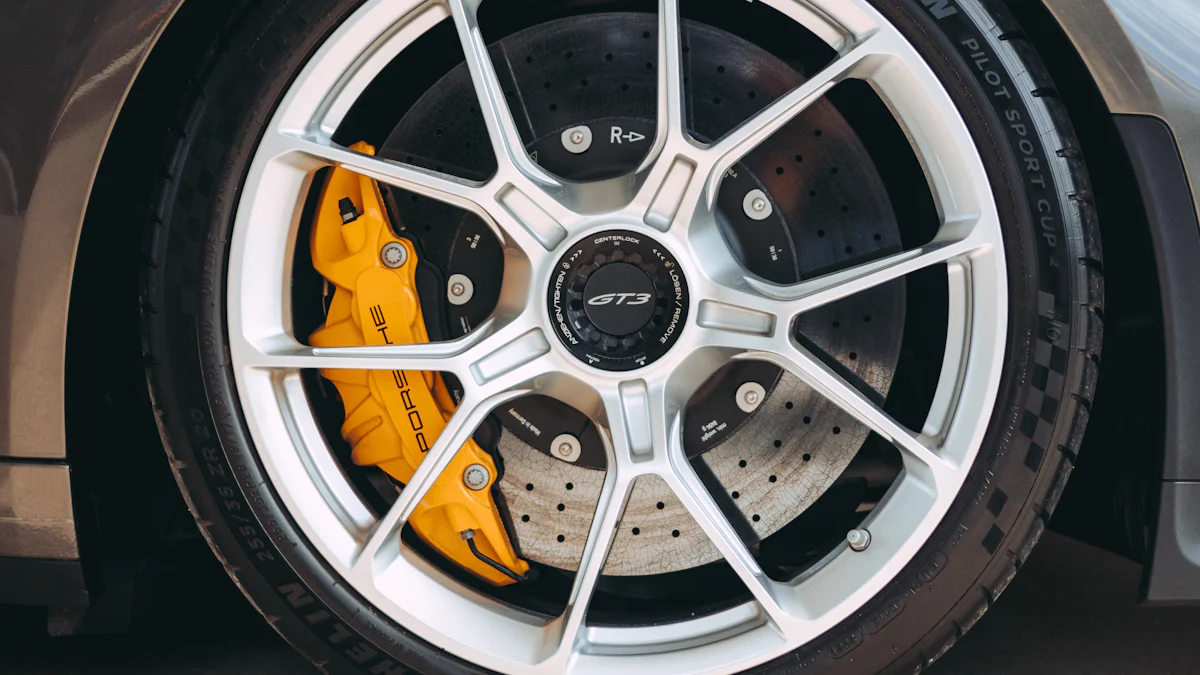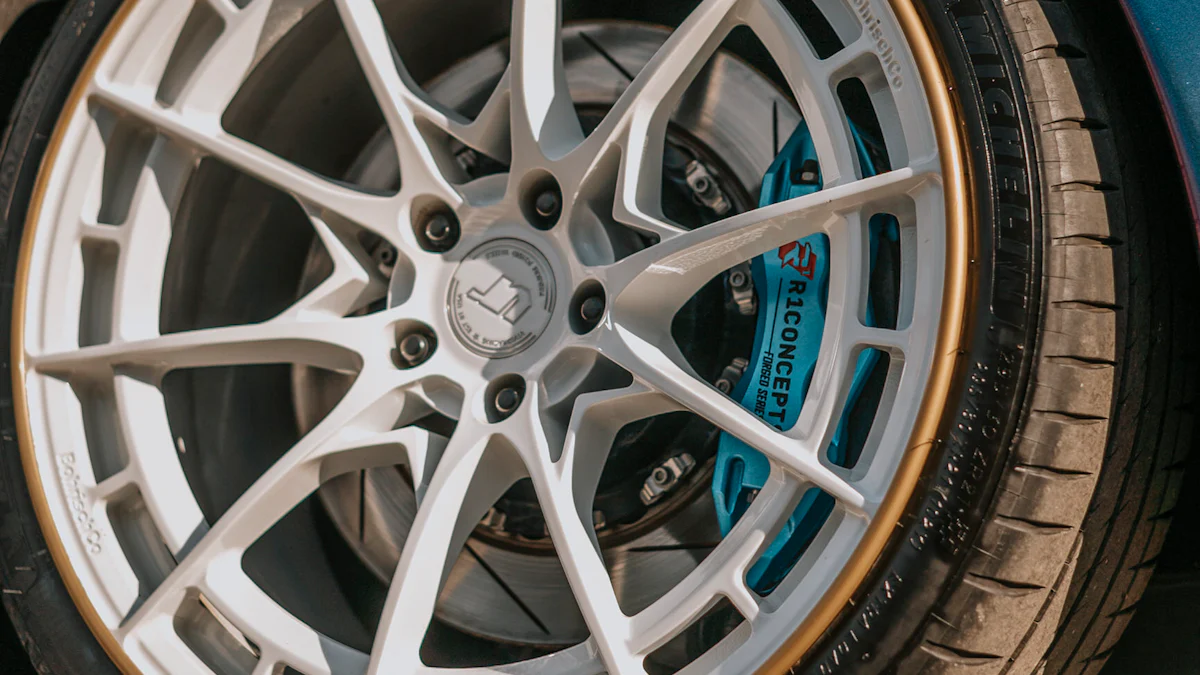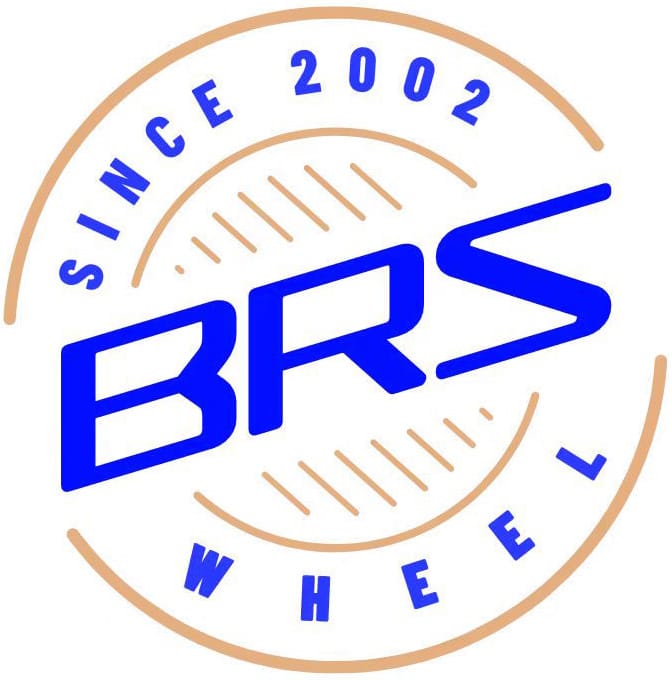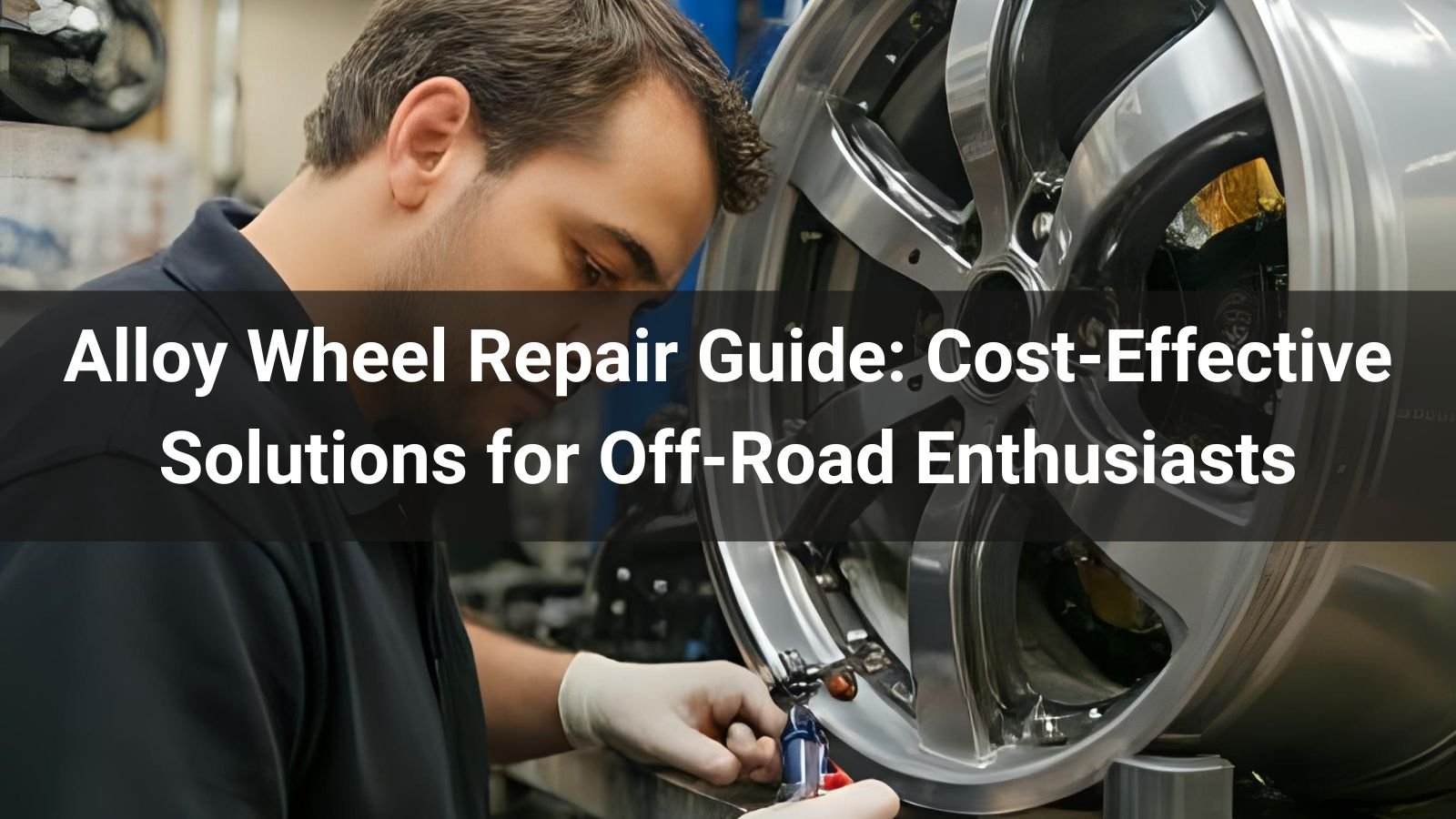
A 16×7 steel rim refers to a wheel with a diameter of 16 inches and a width of 7 inches. These dimensions play a vital role in determining tire compatibility and ensuring proper vehicle handling. The right rim size directly impacts your car’s performance, stability, and safety on the road. Selecting the correct rim width and diameter helps maintain optimal tire pressure and prevents issues like slippage or air loss. Understanding these specifications allows you to make informed decisions, ensuring your vehicle operates efficiently and safely under various driving conditions.
Key Takeaways
- A 16×7 steel rim has a diameter of 16 inches and a width of 7 inches, which are crucial for ensuring proper tire fit and vehicle performance.
- Selecting the right rim size enhances vehicle stability, handling, and safety, preventing issues like tire slippage and air loss.
- Steel rims are known for their durability and cost-effectiveness, making them ideal for winter driving and rough terrains.
When purchasing steel rims, always verify compatibility with your vehicle’s specifications, including diameter, width, and bolt pattern.
Regular maintenance, such as cleaning and inspecting for damage, can significantly extend the lifespan of your steel rims. - Common tire sizes for 16×7 steel rims include 245/75R16 and 265/75R16, providing flexibility for various driving needs.
- Steel rims are easier to repair than alloy rims, making them a practical choice for drivers seeking reliability and value.
Understanding the Dimensions of a 16×7 Steel Rim

What does the ’16’ in 16×7 steel rim represent?
The ’16’ in a 16×7 steel rim refers to the rim’s diameter, measured in inches. This measurement indicates the distance across the rim from one edge to the other, passing through the center. A rim with a 16-inch diameter is designed to accommodate tires specifically made for this size. The diameter plays a crucial role in ensuring that the tire fits securely onto the rim. Using a mismatched tire size can lead to improper fitting, which may compromise safety and vehicle performance.
When selecting a rim, always verify the diameter to match your vehicle’s requirements. For example, a 16-inch rim like the 16×7 steel rim is compatible with tires labeled for 16-inch wheels. This ensures proper alignment and stability during driving.
What does the ‘7’ in 16×7 steel rim represent?
The ‘7’ in a 16×7 steel rim represents the rim’s width, also measured in inches. This width determines the range of tire sizes that can be safely mounted on the rim. A 7-inch rim width typically supports tire widths ranging from 5.5 to 7.5 inches. This flexibility allows you to choose tires that suit your driving needs, whether you prioritize comfort, performance, or durability.
The rim width also affects the tire’s sidewall profile and overall appearance. A wider rim can provide better handling and stability, while a narrower rim may offer a smoother ride. Always ensure that the tire width falls within the recommended range for a 7-inch rim to maintain safety and performance.
Why are these dimensions critical for tire and vehicle compatibility?
The dimensions of a 16×7 steel rim are essential for ensuring compatibility with both the tire and the vehicle. The rim diameter must match the tire’s inner diameter to create a secure fit. A mismatch can lead to issues such as air leakage or tire slippage, which can compromise safety. Similarly, the rim width must align with the tire’s width to maintain proper contact with the road surface.
These dimensions also influence the vehicle’s handling, braking, and overall performance. For instance, a properly fitted rim and tire combination ensures even weight distribution and optimal traction. This is particularly important for maintaining control during cornering or in adverse weather conditions. By understanding the significance of these measurements, you can make informed decisions when selecting rims and tires for your vehicle.
Material and Construction of 16×7 Steel Rims
What makes steel rims durable and reliable?
Steel rims, including the 16×7 steel rim, are known for their exceptional durability and reliability. Steel, as a material, offers high tensile strength, making it resistant to bending or cracking under heavy loads or rough driving conditions. This strength ensures that steel rims can withstand impacts from potholes or curbs without significant damage, which is especially important for vehicles used in rugged terrains or harsh weather.
Another factor contributing to their reliability is their resistance to wear and tear. Steel rims maintain their structural integrity over time, even with frequent use. When properly maintained with a protective coat of paint, they resist rust and corrosion effectively, extending their lifespan. This makes them an excellent choice for winter driving, where exposure to road salt and moisture is common.
In addition to their strength, steel rims are cost-effective. They provide a budget-friendly option without compromising on performance, making them ideal for drivers seeking value and durability.
How are 16×7 steel rims manufactured?
The manufacturing process of 16×7 steel rims involves several precise steps to ensure quality and consistency. It begins with the selection of high-grade steel, which undergoes cutting and shaping to form the rim’s basic structure. Advanced machinery presses the steel into the desired dimensions, ensuring the 16-inch diameter and 7-inch width are accurate.
After shaping, the rims go through welding to join the components securely. This step ensures the rim’s structural stability. The rims then undergo heat treatment to enhance their strength and durability. This process makes the steel more resistant to stress and deformation.
To protect against corrosion, manufacturers apply a coating, often through an electrocoating process. This coating not only prevents rust but also gives the rim a smooth and polished finish. Finally, each rim undergoes rigorous testing in specialized labs to ensure it meets safety and performance standards. These tests include load-bearing assessments and impact resistance evaluations, ensuring the rims are ready for real-world use.
Comparing steel rims to alloy rims: Key differences in material and performance
When comparing steel rims to alloy rims, you’ll notice distinct differences in material and performance. Steel rims, like the 16×7 steel rim, are heavier but more robust. Their weight contributes to better stability, especially in challenging driving conditions. This makes them a preferred choice for heavy-duty vehicles and winter driving.
Alloy rims, on the other hand, are made from aluminum or magnesium alloys. They are significantly lighter, which improves fuel efficiency and handling. Their lightweight nature also enhances braking performance and heat dissipation, making them suitable for high-performance vehicles.
Steel rims are more affordable than alloy rims, offering a cost-effective solution for drivers on a budget. While alloy rims boast a sleek and modern appearance, steel rims prioritize functionality and durability. Steel rims are less prone to cracking or bending, whereas alloy rims may sustain damage under high impact.
Compatibility of 16×7 Steel Rims with Vehicles and Tires

How to determine if a 16×7 steel rim fits your vehicle
To determine if a 16×7 steel rim fits your vehicle, you need to check several key factors. Start by consulting your vehicle’s owner’s manual or the manufacturer’s specifications. These resources provide the recommended rim size for your car. The 16×7 steel rim has a diameter of 16 inches and a width of 7 inches, so your vehicle must support these dimensions for a proper fit.
Next, examine the bolt pattern of the rim. The bolt pattern refers to the number of lug holes and their arrangement on the wheel. Your vehicle’s hub must match this pattern to ensure secure installation. Additionally, consider the rim’s offset, which measures the distance between the mounting surface and the rim’s centerline. A correct offset ensures the rim aligns with your vehicle’s suspension and braking system.
Finally, verify the compatibility of the rim with your tires. The tire’s inner diameter must match the rim’s diameter, and the tire width should fall within the range supported by a 7-inch rim. By checking these factors, you can confidently determine if a 16×7 steel rim is suitable for your vehicle.
Common tire sizes for 16×7 steel rims
The 16×7 steel rim supports a variety of tire sizes, offering flexibility for different driving needs. Common tire sizes include 245/75R16 and 265/75R16, which are widely used for vehicles requiring durability and stability. These tires provide excellent traction and performance, making them ideal for both on-road and off-road conditions.
For narrower options, you can consider tire sizes like 225/75R16 or 235/75R16. These sizes are often used for front tires or vehicles prioritizing fuel efficiency and smoother handling. The 7-inch rim width accommodates tire widths ranging from 5.5 to 7.5 inches, giving you the freedom to choose tires that suit your driving style and preferences.
When selecting tires, always ensure they meet the load and speed ratings specified for your vehicle. Properly matched tires and rims enhance safety, improve handling, and extend the lifespan of both components.
Examples of vehicles that commonly use 16×7 steel rims
Many vehicles are designed to work seamlessly with 16×7 steel rims. These rims are commonly found on trucks, SUVs, and some passenger cars due to their durability and versatility. Popular models include mid-size SUVs like the Toyota 4Runner and Jeep Cherokee, which benefit from the rim’s strength and compatibility with larger tires.
Pickup trucks such as the Ford Ranger and Chevrolet Colorado also frequently use 16×7 steel rims. These vehicles require robust rims to handle heavy loads and challenging terrains. Additionally, some compact SUVs and crossovers, like the Subaru Outback, may use these rims for enhanced stability and performance.
If you’re unsure whether your vehicle supports 16×7 steel rims, consult your manufacturer’s guidelines or seek advice from a trusted tire and wheel specialist. Knowing which vehicles commonly use these rims can help you make an informed decision when upgrading or replacing your wheels.
Advantages and Disadvantages of 16×7 Steel Rims
Benefits of using 16×7 steel rims
Using 16×7 steel rims offers several advantages that make them a practical choice for many drivers. One of the most notable benefits is their durability. Steel, as a material, is incredibly strong and resistant to damage. This strength ensures that steel rims can withstand impacts from potholes, curbs, or rough terrains without bending or cracking. If you frequently drive in challenging conditions, such as off-road trails or poorly maintained roads, steel rims provide the reliability you need.
Another key advantage is affordability. Steel rims are more cost-effective compared to alloy rims. This makes them an excellent option if you are looking for a budget-friendly solution without compromising on performance. Their lower price point also makes them a popular choice for winter tires, where you may not want to invest in more expensive rims that could be exposed to harsh weather and road salt.
Steel rims also excel in winter driving conditions. Their heavier weight provides extra traction on snow and ice, improving stability and control. This added weight helps your vehicle maintain better contact with the road surface, reducing the risk of slipping in icy conditions. If you live in an area with harsh winters, steel rims can enhance your safety during the colder months.
Lastly, steel rims are easy to maintain. They are less prone to cosmetic damage, such as scratches or scuffs, compared to alloy rims. Even if they do sustain minor damage, repairs are often simple and inexpensive. This makes steel rims a low-maintenance option for drivers who prioritize functionality over aesthetics.
Drawbacks of using 16×7 steel rims
While 16×7 steel rims offer many benefits, they also come with a few drawbacks that you should consider. One of the main disadvantages is their weight. Steel rims are heavier than alloy rims, which can impact your vehicle’s overall performance. The added weight may reduce fuel efficiency and slightly affect acceleration. If you prioritize speed and fuel economy, this could be a concern.
Another drawback is their appearance. Steel rims typically have a more utilitarian design, which may not appeal to drivers who value aesthetics. Unlike alloy rims, which often feature sleek and modern designs, steel rims focus on functionality. If you want your vehicle to have a stylish look, steel rims might not meet your expectations.
Corrosion is another potential issue, especially if the protective coating on the rim gets damaged. While steel rims are treated to resist rust, prolonged exposure to moisture and road salt can lead to corrosion over time. Regular maintenance, such as cleaning and applying protective coatings, is necessary to prevent this problem.
Finally, steel rims may not dissipate heat as effectively as alloy rims. This can be a concern if you frequently drive in hot climates or engage in high-performance driving. Excessive heat buildup can affect your tires and braking system, so it’s important to monitor these components if you use steel rims in such conditions.
By weighing these advantages and disadvantages, you can determine whether 16×7 steel rims are the right choice for your vehicle and driving needs.
Key Considerations When Purchasing 16×7 Steel Rims
Factors to evaluate before buying 16×7 steel rims
When purchasing a 16×7 steel rim, you should evaluate several critical factors to ensure the best choice for your vehicle. Start by confirming the rim’s compatibility with your car. Check your vehicle’s manual or consult a professional to verify that the rim’s diameter, width, and bolt pattern align with your car’s specifications. A proper fit ensures safety and optimal performance.
Next, assess the rim’s material quality. Steel rims are known for their durability and strength. Look for rims made from high-grade steel, as this ensures resistance to bending or cracking under heavy loads. Additionally, inspect the protective coating on the rim. A high-quality coating prevents rust and corrosion, especially if you frequently drive in wet or salty conditions.
Consider the rim’s weight and its impact on your driving needs. Steel rims are heavier than alloy rims, which can enhance stability in challenging terrains. However, if fuel efficiency or speed is a priority, you may want to weigh this factor carefully. Lastly, evaluate your budget. Steel rims are cost-effective, offering excellent value for their durability and reliability. Ensure the rim you choose balances affordability with quality.
Where to buy high-quality 16×7 steel rims
Finding a reliable source for high-quality 16×7 steel rims is essential. Start by exploring reputable manufacturers and suppliers. Companies specializing in steel rims often provide products that meet industry standards for safety and performance. For example, manufacturers with certifications like IATF 16949 demonstrate adherence to stringent quality requirements.
Online marketplaces can also be a convenient option. Look for sellers with positive reviews and detailed product descriptions. Ensure they provide information about the rim’s dimensions, material, and compatibility. Many online retailers offer warranties or return policies, giving you added peace of mind.
Local auto parts stores are another excellent resource. Visiting a store allows you to inspect the rims in person and seek advice from knowledgeable staff. Additionally, some vehicle dealerships may carry steel rims designed specifically for your car model. Whether you choose to shop online or in-store, prioritize sellers who offer transparent information and customer support.
Maintenance tips to extend the lifespan of steel rims
Proper maintenance can significantly extend the lifespan of your steel rims. Regular cleaning is crucial. Dirt, road salt, and moisture can accumulate on the rims, leading to corrosion over time. Use mild soap and water to clean the rims, and dry them thoroughly to prevent rust formation.
Inspect the rims periodically for signs of damage. Look for scratches, dents, or chips in the protective coating. Addressing minor issues promptly can prevent more significant problems. If the coating gets damaged, apply a fresh coat of paint or rust-resistant sealant to protect the steel.
Store your rims properly when not in use. If you switch to alloy rims during certain seasons, keep your steel rims in a dry, cool place. Avoid stacking them directly on top of each other to prevent unnecessary pressure or scratches.
Lastly, avoid harsh driving conditions whenever possible. While steel rims are durable, excessive exposure to potholes or curbs can still cause wear and tear. By following these maintenance tips, you can ensure your steel rims remain reliable and functional for years to come.
FAQs
1. Are steel rims more durable than alloy rims?
Yes, steel rims are more durable than alloy rims. Steel rims excel in handling tough environments, such as off-road trails or construction sites. Their high tensile strength makes them resistant to bending or cracking under heavy loads or impacts. This durability ensures they can withstand potholes, curbs, and rugged terrains without significant damage. If you frequently drive in challenging conditions, steel rims provide a reliable and long-lasting option.
2. Can I use steel rims for off-road driving?
Absolutely, steel rims are an excellent choice for off-road driving. Their robust construction allows them to endure the harsh impacts and stresses of uneven terrains. Unlike alloy rims, which may crack under extreme pressure, steel rims maintain their structural integrity. Their heavier weight also enhances stability, making them ideal for vehicles navigating rocky paths or muddy trails.
3. What tire sizes work best with 16×7 steel rims?
A 16×7 steel rim supports a range of tire sizes. Common options include 245/75R16 and 265/75R16, which provide excellent traction and stability for various driving conditions. For narrower tires, you can consider 225/75R16 or 235/75R16, especially if you prioritize smoother handling or fuel efficiency. On vehicles like a 1971 Ford F100, you might use 265s for the rear and narrower options like 225s or 235s for the front, depending on your preferences and driving needs. Always consult a tire professional to ensure the selected size aligns with your vehicle’s specifications.
4. Why should I choose steel rims over alloy rims?
If you value functionality and reliability over aesthetics, choose steel rims as an excellent option.
5. Are steel rims easy to maintain?
Yes, steel rims are relatively easy to maintain. Regular cleaning with mild soap and water helps prevent rust and corrosion. Inspect the rims periodically for scratches or chips in the protective coating, and address any damage promptly by applying a rust-resistant sealant. Proper storage in a dry, cool place during off-seasons also extends their lifespan. With minimal effort, you can keep your steel rims in excellent condition for years.
6. Can I use steel rims year-round?
You can use steel rims year-round, but they are particularly beneficial in winter. Their durability and resistance to damage make them ideal for harsh weather conditions, such as snow and ice. However, some drivers prefer switching to alloy rims during warmer months for improved fuel efficiency and aesthetics. If you choose to use steel rims year-round, ensure regular maintenance to protect them from rust and wear.
7. Are steel rims suitable for all vehicles?
Steel rims are compatible with many vehicles, including trucks, SUVs, and some passenger cars. They are commonly used on models like the Toyota 4Runner, Jeep Cherokee, Ford Ranger, and Chevrolet Colorado. These vehicles benefit from the strength and stability steel rims provide. To confirm compatibility, check your vehicle’s manual or consult a tire and wheel specialist. Matching the rim’s dimensions, bolt pattern, and offset with your vehicle ensures a proper fit and optimal performance.
Understanding the specifications of a 16×7 steel rim is essential for making informed decisions about your vehicle. You now know how dimensions like diameter and width impact tire compatibility and performance. The material and construction of steel rims highlight their durability and reliability. Evaluating compatibility, weighing the pros and cons, and considering key factors before purchasing ensures you choose the right rim for your needs. Always prioritize quality and confirm the rim fits your vehicle. By aligning your driving requirements with these insights, you can enhance safety and performance on the road.
FAQ
What are the advantages of using steel rims?
Steel rims offer several benefits that make them a practical choice for many drivers. Their durability stands out as a key advantage. Steel rims can handle rough roads, potholes, and harsh weather conditions without bending or cracking. If you frequently drive in winter or on uneven terrains, steel rims provide the strength and reliability you need.
Another benefit is their weight. Steel rims are heavier than alloy rims, which enhances traction on snow and ice. This makes them an excellent option for winter driving. Many car owners keep a separate set of steel rims specifically for winter tires. Steel rims also contract less than aluminum in cold weather, helping maintain proper tire pressure during freezing temperatures.
Lastly, steel rims are cost-effective. They provide a budget-friendly solution without compromising on performance. If you prioritize functionality over aesthetics, steel rims are a smart investment.
What are the limitations of steel rims compared to aluminum rims?
Steel rims have some limitations when compared to aluminum rims. One of the main drawbacks is their appearance. Steel rims typically come in basic designs with limited options for finishes or styles. If you value customization or want a more personalized look for your vehicle, aluminum rims might be a better choice.
Another limitation is their weight. While the extra weight of steel rims improves traction in winter, it can reduce fuel efficiency and slightly impact acceleration. If you prioritize speed or fuel economy, this could be a concern.
Finally, steel rims are not ideal for high-performance vehicles. Their utilitarian design focuses on durability rather than aesthetics or lightweight performance. For sports cars or vehicles where style and speed are priorities, aluminum rims are often preferred.
Can steel rims handle extreme weather conditions?
Yes, steel rims perform exceptionally well in extreme weather conditions. Their robust construction makes them resistant to damage from snow, ice, and road salt. In winter, their heavier weight provides better traction, helping your vehicle maintain stability on slippery roads. Steel rims also contract less than aluminum in cold temperatures, which helps preserve proper tire pressure.
For areas with harsh winters, steel rims are a reliable choice. However, regular maintenance, such as cleaning off road salt and applying protective coatings, ensures they remain in good condition over time.
Are steel rims suitable for off-road driving?
Steel rims are an excellent choice for off-road driving. Their durability allows them to withstand impacts from rocks, uneven terrain, and other obstacles commonly encountered off-road. Unlike alloy rims, which may crack under extreme pressure, steel rims maintain their structural integrity even in challenging conditions.
Their heavier weight also enhances stability, making them ideal for vehicles navigating rocky paths or muddy trails. If you frequently drive off-road, steel rims provide the reliability and toughness you need.
How do I maintain steel rims to prevent rust?
Proper maintenance is essential to prevent rust on steel rims. Start by cleaning your rims regularly with mild soap and water. Dirt, road salt, and moisture can accumulate and lead to corrosion if not removed. After cleaning, dry the rims thoroughly to eliminate any lingering moisture.
Inspect your rims periodically for scratches or chips in the protective coating. If you notice any damage, apply a rust-resistant sealant or touch-up paint to protect the exposed steel. During off-seasons, store your steel rims in a dry, cool place to minimize exposure to moisture. Following these steps will help extend the lifespan of your steel rims.
Can I use steel rims year-round?
You can use steel rims year-round, but they are particularly beneficial in winter. Their durability and weight provide extra traction on snow and ice, making them ideal for cold-weather driving. However, some drivers prefer switching to alloy rims during warmer months for improved fuel efficiency and aesthetics.
If you decide to use steel rims throughout the year, ensure regular maintenance to protect them from rust and wear. Cleaning and inspecting them frequently will keep them in excellent condition regardless of the season.
What vehicles are best suited for steel rims?
Steel rims are commonly used on trucks, SUVs, and some passenger cars. Vehicles like the Toyota 4Runner, Jeep Cherokee, Ford Ranger, and Chevrolet Colorado often benefit from the strength and durability of steel rims. These vehicles require robust wheels to handle heavy loads, rough terrains, or challenging weather conditions.
If you’re unsure whether steel rims are suitable for your vehicle, consult your owner’s manual or speak with a tire and wheel specialist. Matching the rim’s dimensions, bolt pattern, and offset with your vehicle ensures a proper fit and optimal performance.
Why should I choose steel rims over alloy rims?
Steel rims are a practical choice if you prioritize durability, affordability, and functionality. They are more resistant to damage from impacts, making them ideal for rough roads and off-road driving. Their cost-effectiveness also makes them a popular option for winter tires, where you may not want to invest in more expensive alloy rims.
Additionally, steel rims are easier to repair. If a steel rim bends, you can often hammer it back into shape, whereas alloy rims may require costly replacements. For drivers seeking reliability and value, steel rims are an excellent option.
What tire sizes work best with 16×7 steel rims?
A 16×7 steel rim supports a variety of tire sizes, offering flexibility for different driving needs. Common options include 245/75R16 and 265/75R16, which provide excellent traction and stability. For narrower tires, you can consider 225/75R16 or 235/75R16, especially if you prioritize smoother handling or fuel efficiency.
Always consult a tire professional to ensure the selected size aligns with your vehicle’s specifications. Properly matched tires and rims enhance safety, improve handling, and extend the lifespan of both components.
Are steel rims easy to repair?
Yes, steel rims are relatively easy to repair. If a steel rim bends due to an impact, you can often straighten it using basic tools. This makes steel rims a cost-effective option, as repairs are usually simpler and less expensive compared to alloy rims. However, for severe damage, it’s best to consult a professional to ensure the rim remains safe for use.
- Posted In:General






